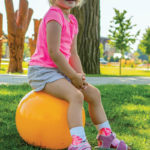
iStockphoto.com 1043744904
Practice may help kids get active
By Katie Bell
Iyengar yoga can improve both malalignment of the lower extremities during ambulation as well as emotional functioning in children with obesity, according to a pilot study from Milwaukee, Wisconsin, supporting a role for yoga in pediatric obesity.
“This is the first study to examine the benefits of yoga for gait in youths with obesity,” reported Keri Hainsworth, PhD, associate professor in the Department of Anesthesiology at the Medical College of Wisconsin.
According to Hainsworth and colleagues, obesity negatively impacts the kinematics and kinetics of the lower extremities in children and adolescents. They noted that following participation in a yoga program, participants demonstrated small but significant improvements in gait, reflecting reduced lower extremity malalignment and increased strength of the hip flexors and adductors during ambulation, especially at the knee and hip joints.
The primary outcome of the study was the benefits of yoga for gait; secondary outcomes included health-related quality of life (HRQoL), physical activity, and pain. The researchers also assessed the feasibility and acceptability of the yoga intervention.
The study included nine participants (five girls) with a median age of 14 years. All of the adolescents had a body mass index in the 99th percentile or above and had no yoga experience. The participants took part in an eight-week Iyengar yoga intervention of biweekly, one-hour classes.
All participants underwent gait analysis within two weeks of the start of the yoga intervention and within a week of its end. Researchers assessed children’s self-reported and parent-proxy HRQoL reports and physical activity at baseline and after the intervention. The children self-reported pain at the start of each yoga class.
“The QoL improvements across all functions could increase the willingness of teens to be more active and try new activities.”
—Sara Shultz, PhD, ATC
The children had significant improvements in multiple gait parameters, including hip, knee, and ankle motion and moments, after the eight-week yoga intervention.
Specifically, there was increased hip adduction and decreased hip abduction in both the stance and swing phases of gait. Additionally, gait analysis revealed increased knee valgus at heel contact but reduced knee varus during stance phase and initial swing phase. Meanwhile, the ankle joint showed increased plantar flexion but reduced dorsiflexion during swing phase.
Further, the hip internal rotation moment at heel contact in the stance phase was increased from a median of 0.02 to 0.03 Nm/kg and the maximum adduction moment in stance phase was reduced from a median of 0.12 to 0.09 Nm/kg. While cadence and velocity reduced from pre- to post-yoga, stride length did not change from pre- to postintervention.
“Overall, the pattern of results shows reduced malalignment during walking, particularly at the hip and knee joints,” the authors wrote.
Participants self-reported both improved overall HRQoL and psychosocial functioning, while parent-proxy reports of emotional functioning also improved after the yoga intervention.
The authors could not measure of changes in pain intensity because of the sample size and number of participants who reported pain. The amount of time spent in physical activity did not change from pre- to post intervention. Additionally, the study found the yoga intervention to be both feasible and acceptable, as measured by class participation and a Holistic Health Questionnaire, respectively.
The findings were published in July by the journal Children.
“Overall, the results of this study suggest that positive changes in gait are achievable with a relatively brief, noninvasive intervention,” the authors wrote. “After an eight-week Iyengar yoga intervention, children and adolescents with obesity were able to walk more efficiently, with reduced abnormal alignment of the lower limbs, have less impaired mobility, and better balance,” they added.
The authors suggested that “better understanding of activities that improve the daily functioning of obese youth may allow for the development of effective interventions.”
Commenting on the study, Sarah Shultz, PhD, ATC, associate professor and chair of the Department of Kinesiology at Seattle University in Washington, said she believed the most important aspect of the yoga intervention were the improvements in HRQoL.
“The changes in gait are really mini- mal− and are probably not that clinically significant−but the perceived improvements by the students in quality of life across all functions is incredible and could lead to increased willingness by the teens to be more physically active and try new activities,” she said.
In many children, said Shultz, the willingness to be active is more important than the capability. “In a lot of cases of youth struggling with obesity, once you get over that initial barrier [to activity], then a more sustained practice of exercise can be achieved,” she said.
This study adds to a limited body of knowledge that looks beyond the traditional forms of exercise, such as running, biking, swimming, said Shultz.
“The purpose of exercise interventions should be to help youth with obesity find alternatives that increase their engagement with activity, and thus lead to more sustainable changes in lifestyle,” she said. “Yoga practice is an excellent example of how to use more nontraditional approaches to engage students with exercise.”
Katie Bell is a freelance writer based in New York City.
Source:
Hainsworth KR, Liu XC, Simpson PM, et al. A pilot study of Iyengar yoga for pediatric obesity: Effects on gait and emotional functioning. Children (Basel) 2018;5(7):92.





